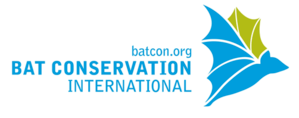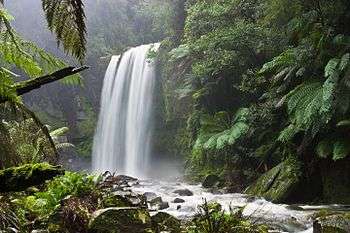Bat Conservation International
 | |
| Founded | October 2, 1982 |
|---|---|
| Founder | Merlin D. Tuttle[1] |
| Type | Charitable trust |
| Focus | Environmentalism, Conservation |
| Location | |
| Origins | Milwaukee, Wisconsin |
Area served | Worldwide |
Key people | Executive Director: Mike Daulton |
| Website | batcon.org |
Bat Conservation International (BCI) is an international non-governmental organization working to conserve the world's bats and their habitats through conservation, education and research efforts.
BCI was founded in 1982 by prominent bat biologist Dr. Merlin Tuttle. Since its establishment, BCI has formed lasting partnerships with the US Fish & Wildlife Service and many national and international agencies and nonprofits, and has produced publications, workshops, scholarships and research, and site-specific projects across the nation and around the world. Currently, BCI employs a staff of 30 biologists, educators, and administrators and is supported by members in 60 countries.
Conservation strategies
BCI operates by its "ten critical conservation strategies." These strategies consist of:
1) Accelerating scientific research
2) Preventing extinction
3) Protecting intact areas with highly-diverse bat communities
4) Preserving mega-populations of bats
5) Creating global and regional partnerships
6) Addressing threats impacting multiple species at multiple sites
7) Promoting community-based bat conservation
8) Creating and enforcing legal and policy frameworks
9) Developing and perfecting important technology
10) Investing in future conservation leadership[2]
Addressing serious threats
BCI funds and participates in research to mitigate damage to bat populations. Some of the threats previously or currently addressed include:
- The effects of uranium mines on bats that use them as roosts[3]
- Ways to reduce bat mortality from wind turbines[3]
- Mass-mortality from white-nose syndrome
- Guano mining in bat caves
Protecting mega-populations
Many bat species are colonial, and form colonies that can consist of millions of individuals.[4] Because some bat species are highly aggregated, entire species can be threatened by disturbance to a small number of roosts.[5] BCI seeks to protect these roosts of high aggregations, or "mega-populations."[3] Some ways that BCI works to protect mega-populations are:
- Determining the effects of cave gates on bat usage of caves[3]
- Purchasing land with important caves, such as Bracken Cave, home of the world's largest bat colony[6]
- Using education and outreach to protect bat roosts from purposeful eradication, such as the colony at the Congress Avenue Bridge that was initially unwelcome[7]
Preventing extinction
In their 2014–2018 Strategic Plan, BCI identified 35 critically endangered or endangered species of bat as priority species for conservation. These 35 species will receive a concentrated focus of research and conservation efforts to hopefully prevent their extinction.[3] BCI is also a member of the Alliance for Zero Extinction, which seeks to safeguard the last habitats of critically endangered species.[2]
Political advocacy
In addition to promoting scientific research on bats and their conservation, BCI is also involved in public policy. BCI will announce opposition to legislation to mobilize its members against it, such as with Pennsylvania House Bill 1576, which would have changed how threatened and endangered species are protected in the state.[3] In the future, BCI plans to increase its engagement in legislative and policy efforts to conserve bats.[2]
See also
|
|
References
- ↑
- 1 2 3 "A Five-Year Plan for Global Bat Conservation" (PDF). batcon.org. Bat Conservation International. October 2013. Retrieved May 1, 2017.
- 1 2 3 4 5 6 "Annual Report 2013-2014" (PDF). batcon.org. Bat Conservation International. August 2014. Retrieved May 1, 2017.
- ↑ Betke, M., Hirsh, D. E., Makris, N. C., McCracken, G. F., Procopio, M., Hristov, N. I., ... & Crampton, S. (2008). Thermal imaging reveals significantly smaller Brazilian free-tailed bat colonies than previously estimated. Journal of Mammalogy, 89(1), 18–24.
- ↑ McCracken, G. F. (2011). Cave conservation: special problems of bats. Course Booklet, 68.
- ↑ "Protecting a Jewel in Texas". batcon.org. Bat Conservation International. Retrieved May 1, 2017.
- ↑ "Congress Avenue Bridge". batcon.org. Bat Conservation International. Retrieved May 1, 2017.
- ↑ Arroyo-Cabrales, J. & Ospina-Garces, S. 2016. Myotis sodalis. The IUCN Red List of Threatened Species 2016: e.T14136A22053184. doi:10.2305/IUCN.UK.2016-1.RLTS.T14136A22053184.en. Downloaded on 01 May 2017.
- ↑ Solari, S. 2016. Eumops floridanus. The IUCN Red List of Threatened Species 2016: e.T136433A21984011. doi:10.2305/IUCN.UK.2016-1.RLTS.T136433A21984011.en. Downloaded on 01 May 2017.
- ↑ Medellín, R. 2016. Leptonycteris nivalis. The IUCN Red List of Threatened Species 2016: e.T11697A22126172. doi:10.2305/IUCN.UK.2016-1.RLTS.T11697A22126172.en. Downloaded on 01 May 2017.
- ↑ Solari, S. 2016. Natalus jamaicensis. The IUCN Red List of Threatened Species 2016: e.T136824A22043871. doi:10.2305/IUCN.UK.2016-1.RLTS.T136824A22043871.en. Downloaded on 01 May 2017.
- ↑ Solari, S. 2016. Pteronotus paraguanensis. The IUCN Red List of Threatened Species 2016: e.T136610A21987754. doi:10.2305/IUCN.UK.2016-1.RLTS.T136610A21987754.en. Downloaded on 01 May 2017.
- ↑ Solari, S. 2016. Lonchorhina fernandezi. The IUCN Red List of Threatened Species 2016: e.T12271A22039142. doi:10.2305/IUCN.UK.2016-2.RLTS.T12271A22039142.en. Downloaded on 01 May 2017.
- ↑ Solari, S. 2016. Lonchorhina marinkellei. The IUCN Red List of Threatened Species 2016: e.T12272A22038923. doi:10.2305/IUCN.UK.2016-2.RLTS.T12272A22038923.en. Downloaded on 01 May 2017.
- ↑ Ramirez-Chaves, H. & Suárez-Castro, A. 2015. Platyrrhinus chocoensis. The IUCN Red List of Threatened Species 2015: e.T17568A21987035. doi:10.2305/IUCN.UK.2015-4.RLTS.T17568A21987035.en. Downloaded on 01 May 2017.
- ↑ Tirira, D. 2015. Balantiopteryx infusca. (errata version published in 2016) The IUCN Red List of Threatened Species 2015: e.T2531A97206692. Downloaded on 01 May 2017.
- ↑ Velazco, P., Huamani, L. & Cadenillas, R. 2015. Amorphochilus schnablii. The IUCN Red List of Threatened Species 2015: e.T1154A22070889. doi:10.2305/IUCN.UK.2015-4.RLTS.T1154A22070889.en. Downloaded on 01 May 2017.
- ↑ Solari, S. & Boada, C. 2016. Sturnira nana. The IUCN Red List of Threatened Species 2016: e.T20958A22050195. doi:10.2305/IUCN.UK.2016-1.RLTS.T20958A22050195.en. Downloaded on 01 May 2017.
- ↑ Mickleburgh, S., Hutson, A.M., Bergmans, W. & Fahr, J. 2008. Hipposideros lamottei. The IUCN Red List of Threatened Species 2008: e.T10141A3173193. doi:10.2305/IUCN.UK.2008.RLTS.T10141A3173193.en. Downloaded on 01 May 2017.
- ↑ Fahr. J. 2008. Rhinolophus maclaudi. The IUCN Red List of Threatened Species 2008: e.T19549A8973675. doi:10.2305/IUCN.UK.2008.RLTS.T19549A8973675.en. Downloaded on 01 May 2017.
- ↑ Fahr. J. 2008. Rhinolophus ziama. The IUCN Red List of Threatened Species 2008: e.T44786A10939382. doi:10.2305/IUCN.UK.2008.RLTS.T44786A10939382.en. Downloaded on 01 May 2017.
- ↑ Fahr. J. 2010. Rhinolophus hilli. The IUCN Red List of Threatened Species 2010: e.T44781A10937550. doi:10.2305/IUCN.UK.2010-2.RLTS.T44781A10937550.en. Downloaded on 01 May 2017.
- ↑ Mickleburgh, S., Hutson, A.M. & Bergmans, W. 2008. Pteropus rodricensis. The IUCN Red List of Threatened Species 2008: e.T18755A8565719. doi:10.2305/IUCN.UK.2008.RLTS.T18755A8565719.en. Downloaded on 01 May 2017.
- ↑ Gerlach, J., Mickleburgh, S., Hutson, A.M. & Bergmans, W. 2008. Coleura seychellensis. The IUCN Red List of Threatened Species 2008: e.T5112A11115279. doi:10.2305/IUCN.UK.2008.RLTS.T5112A11115279.en. Downloaded on 01 May 2017.
- ↑ Mildenstein, T. and Paguntalan, L. 2016. Acerodon jubatus. The IUCN Red List of Threatened Species 2016: e.T139A21988328. doi:10.2305/IUCN.UK.2016-2.RLTS.T139A21988328.en. Downloaded on 01 May 2017.
- ↑ Heaney, L., Ong, P., Tabaranza, B., Rosell-Ambal, G., Balete, D., Alcala, E., Paguntulan, L.M., Pedregosa, S. & Cariño, A.B. 2008. Dobsonia chapmani. The IUCN Red List of Threatened Species 2008: e.T6773A12804243. doi:10.2305/IUCN.UK.2008.RLTS.T6773A12804243.en. Downloaded on 01 May 2017
- ↑ Allison, A., Bonaccorso, F., Helgen, K. & James, R. 2008. Pteropus mariannus. The IUCN Red List of Threatened Species 2008: e.T18737A8516291. doi:10.2305/IUCN.UK.2008.RLTS.T18737A8516291.en. Downloaded on 01 May 2017.
- ↑ Helgen, K. & Wiles, G. (2009). "Pteropus insularis". IUCN Red List of Threatened Species. Version 3.1 (3.1). International Union for Conservation of Nature. Retrieved 24 December 2013.
- ↑ Bonaccorso, F. & Allison, A. 2008. Emballonura semicaudata. The IUCN Red List of Threatened Species 2008: e.T7669A12841889. doi:10.2305/IUCN.UK.2008.RLTS.T7669A12841889.en. Downloaded on 01 May 2017.
- ↑ Aplin, K., Armstrong, K. & Wright, D. 2016. Aproteles bulmerae. The IUCN Red List of Threatened Species 2016: e.T1933A22136238. doi:10.2305/IUCN.UK.2016-1.RLTS.T1933A22136238.en. Downloaded on 01 May 2017.
- ↑ Bonaccorso, F., Hamilton, S. & Parnaby, H. 2008. Pharotis imogene. The IUCN Red List of Threatened Species 2008: e.T16887A6543777. doi:10.2305/IUCN.UK.2008.RLTS.T16887A6543777.en. Downloaded on 01 May 2017.
- ↑ Helgen, K., Hamilton, S., Leary, T. & Bonaccorso, F. 2008. Pteralopex anceps. The IUCN Red List of Threatened Species 2008: e.T18656A8504526. doi:10.2305/IUCN.UK.2008.RLTS.T18656A8504526.en. Downloaded on 01 May 2017.
- ↑ Helgen, K., Hamilton, S. & Leary, T. 2008. Pteralopex flanneryi. The IUCN Red List of Threatened Species 2008: e.T136587A4315225. doi:10.2305/IUCN.UK.2008.RLTS.T136587A4315225.en. Downloaded on 01 May 2017.
- ↑ Helgen, K. & Hamilton, S. 2008. Pteralopex atrata. The IUCN Red List of Threatened Species 2008: e.T18657A8504692. doi:10.2305/IUCN.UK.2008.RLTS.T18657A8504692.en. Downloaded on 01 May 2017.
- ↑ James, R., Hamilton, S. & Helgen, K. 2008. Pteropus cognatus. The IUCN Red List of Threatened Species 2008: e.T136397A4286239. doi:10.2305/IUCN.UK.2008.RLTS.T136397A4286239.en. Downloaded on 01 May 2017.
- ↑ Leary, T., Helgen, K. & Hamilton, S. 2008. Pteralopex pulchra. (errata version published in 2016) The IUCN Red List of Threatened Species 2008: e.T18658A103392586. Downloaded on 01 May 2017.
- ↑ Hamilton, S., Helgen, K., James, R., Fisher, D. & Parnaby, H. 2008. Pteralopex taki. The IUCN Red List of Threatened Species 2008: e.T29473A9500602. doi:10.2305/IUCN.UK.2008.RLTS.T29473A9500602.en. Downloaded on 01 May 2017.
- ↑ Leary, T., Hamilton, S. & James, R. 2008. Pteropus nitendiensis. The IUCN Red List of Threatened Species 2008: e.T18744A8535844. doi:10.2305/IUCN.UK.2008.RLTS.T18744A8535844.en. Downloaded on 01 May 2017.
- ↑ Leary, T., Hamilton, S. & James, R. 2008. Pteropus tuberculatus. The IUCN Red List of Threatened Species 2008: e.T18765A8590245. doi:10.2305/IUCN.UK.2008.RLTS.T18765A8590245.en. Downloaded on 01 May 2017.
- ↑ Helgen, K. & Hamilton, S. 2008. Pteropus fundatus. The IUCN Red List of Threatened Species 2008: e.T18724A8510939. doi:10.2305/IUCN.UK.2008.RLTS.T18724A8510939.en. Downloaded on 01 May 2017.
- ↑ Helgen, K., Palmeirim, J. & Allison, A. 2008. Mirimiri acrodonta. The IUCN Red List of Threatened Species 2008: e.T18655A8504355. doi:10.2305/IUCN.UK.2008.RLTS.T18655A8504355.en. Downloaded on 01 May 2017.
- ↑ Palmeirim, J. 2014. Chaerephon bregullae. The IUCN Red List of Threatened Species 2014: e.T4309A67360775. doi:10.2305/IUCN.UK.2014-3.RLTS.T4309A67360775.en. Downloaded on 01 May 2017.
- ↑ "Adventures With a Bat Biologist". To the Best of Our Knowledge via WNYC. August 28, 2016. Retrieved November 3, 2016.
